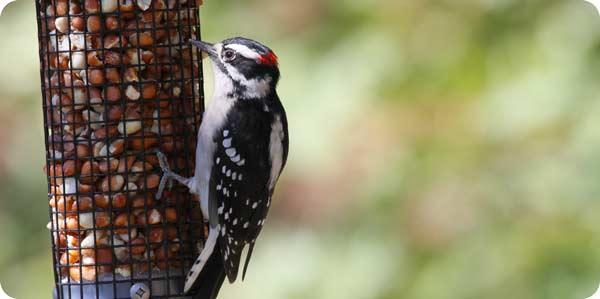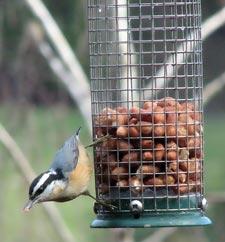Peanut Feeders: Attract the Interesting Birds
 Downy Woodpecker - Local photo by Risa George
Downy Woodpecker - Local photo by Risa George
Why should you put out a peanut feeder? For starters:
- Peanuts are a high-fat, high-protein food that's good for birds
- Shelled peanuts are a low-mess food
- Most peanut feeders can also be used with Bark Butter Bits, peanut-flavored suet nuggets that can be mixed with peanuts or offered on their own. (Also available in a hot pepper version to deter squirrels and rodents.)
But when it comes down to the core backyard birdwatching experience, the point of any new feeder is to increase your enjoyment of the birds in your yard. This is how they do that:
Attract More Interesting Birds
|
Red-breasted Nuhatch |
In one sense, there are two main categories of feeder-visiting birds. First there are the finches—colorful and musical, but also numerous and largely indistinguishable from each other. Then there are those species which are less abundant and more individual in their personalities: titmice, woodpeckers, chickadees, nuthatches, jays, and the like. While some of these birds flock to some degree at certain times of the year, none of them are as firmly bound to those anonymous, large flocks that characterize the finches. These are the birds that make you say “the woodpecker is here” rather than “there’s a house finch on the feeder.”
When you put out a sunflower feeder with easy comfortable perches, your feeder space is probably occupied much of the time by the anonymous finch masses. When you put out a mesh peanut feeder, the combination of food preferences and clinging comfort means that you are putting out a feeder that will mainly attract the birds with more character: titmice, chickadees, nuthatches, woodpeckers, and jays.
See More Interesting Bird Behavior
Clinging: If you’ve ever used a finch sock, you’ve seen finches cling sideways and upside down, engaging acrobatically with the feeder in a way reminiscent of plucking seeds from a thistle flower or picking apart some alder cones. In comparison, feeders with convenient perches can seem somewhat monotonous. In the same way, clinging to a mesh peanut feeder encourages movement on the feeder rather than boring immobility. Give your birds some exercise!
Caching: While the anonymous finch masses can bite and swallow, many nut-eating birds have made the notable leap in evolutionary tactics of saving food for later. While several species will cache nuts, jays are the champions of this, capable of burying thousands of acorns in a season, some of which will germinate and develop into the next generation of oaks. Think of jay peanut caching as training sessions for developing their acorn planting skills.
Playing with their food: Peanuts encourage titmice and chickadees to carry off a hefty morsel of food to a nearby perch for holding between their feet, hammering with their beaks, and generally wrestling their food into submission. Peanuts in the shell offer another engaging eating experience, as jays and woodpeckers break open shells to get at the nut inside. Both of these behaviors require more versatility than the finches' bite 'n' swallow and are scientifically considered a real step in evolutionary development.
Ready to add a peanut feeder to your yard? Check out one of our favorites on our online store, or come visit us to see our complete selection.


